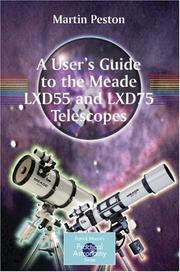| Listing 1 - 2 of 2 |
Sort by
|

ISBN: 9780387682648 0387364897 9780387364896 0387682643 Year: 2010 Publisher: New York, NY Springer New York
Abstract | Keywords | Export | Availability | Bookmark
 Loading...
Loading...Choose an application
- Reference Manager
- EndNote
- RefWorks (Direct export to RefWorks)
This is a fully comprehensive guide to "choosing and using" the LXD55 / 75 computer-controlled – "go to" – series of telescopes. It is intended both for beginners and more advanced practical amateur astronomers. The LXD series of telescopes is unusual in having German Equatorial Mounts – GEMs – rather than the more common altazimuth design. Although setting up a GEM with a go-to system is more involved than setting up the equivalent altazimuth mount, there are many advantages in the system, including zero field rotation. A User’s Guide to the Meade LXD55 and LXD75 Telescopes contains a wealth of information on setting up, using and maintaining the telescope, along with lots of hints, tips, and tricks for getting the very best out of it. Coverage in advanced techniques for experienced astronomers and LXD users include imaging, interfacing with a PC or laptop, using available accessories, and troubleshooting.
Popular Science. --- Popular Science in Astronomy. --- Science (General). --- Telescopes. --- Telescopes -- Amateurs' manuals. --- Telescopes --- Astronomical telescopes --- Optical telescopes --- Telescope --- Popular works. --- Observations, Astronomical. --- Astronomy --- Astronomy. --- Astronomy, Observations and Techniques. --- Observations. --- Astronomical instruments --- Optical instruments --- Astronomy—Observations. --- Astronomical observations --- Observations, Astronomical
Book
ISBN: 8847010934 9788847010932 8847010926 9788847010925 Year: 2007 Publisher: Milano Springer Milan
Abstract | Keywords | Export | Availability | Bookmark
 Loading...
Loading...Choose an application
- Reference Manager
- EndNote
- RefWorks (Direct export to RefWorks)
Non sono necessariamente richiesti strumenti mastodontici per produrre risultati scientificamente validi nel campo dell’astronomia. Anche l’astrofilo dotato di un piccolo telescopio, con un diametro di soli 8-9 cm, può contribuire alla scienza del cielo realizzando utili osservazioni del Sole, della Luna, dei pianeti, delle comete, degli asteroidi, delle stelle doppie o variabili, delle nebulose e degli ammassi stellari. Il manuale di M.K. Gainer spiega quale sia la dotazione minima (un piccolo telescopio, un computer, una semplice fotocamera digitale), come utilizzarla, e quali siano le tecniche appropriate da adottare nelle osservazioni. Offre inoltre schemi per interpretare e ridurre i dati raccolti, nonché schede da compilare e da spedire ai centri di raccolta internazionali. Questo libro è il passaporto grazie al quale l’astrofilo può entrare a pieno titolo nel mondo affascinante della scienza astronomica.
Astronomy. --- Telescopes. --- Astronomical telescopes --- Optical telescopes --- Telescope --- Popular Science. --- Popular Science in Astronomy. --- Science (General). --- Astronomical photography -- Amateurs' manuals. --- Astronomy -- Amateurs' manuals. --- Telescopes -- Amateurs' manuals. --- Popular works. --- Observations, Astronomical. --- Astronomy --- Astronomy, Observations and Techniques. --- Observations. --- Physical sciences --- Space sciences --- Astronomical instruments --- Optical instruments --- Astronomy—Observations. --- Astronomical observations --- Observations, Astronomical
| Listing 1 - 2 of 2 |
Sort by
|

 Search
Search Feedback
Feedback About UniCat
About UniCat  Help
Help News
News